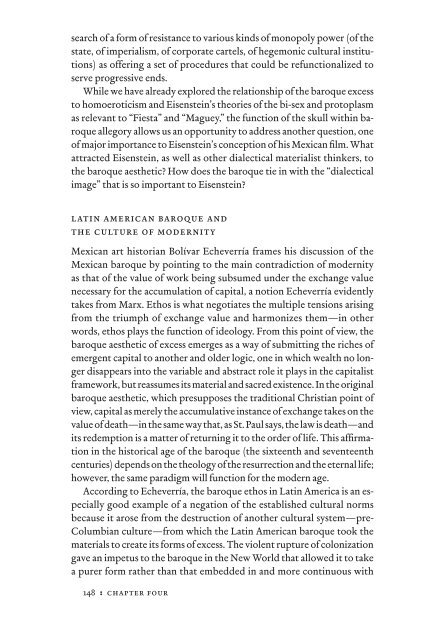In Excess: Sergei Eisentein's Mexico - Cineclub
In Excess: Sergei Eisentein's Mexico - Cineclub
In Excess: Sergei Eisentein's Mexico - Cineclub
You also want an ePaper? Increase the reach of your titles
YUMPU automatically turns print PDFs into web optimized ePapers that Google loves.
search of a form of resistance to various kinds of monopoly power (of the<br />
state, of imperialism, of corporate cartels, of hegemonic cultural institutions)<br />
as offering a set of procedures that could be refunctionalized to<br />
serve progressive ends.<br />
While we have already explored the relationship of the baroque excess<br />
to homoeroticism and Eisenstein’s theories of the bi-sex and protoplasm<br />
as relevant to “Fiesta” and “Maguey,” the function of the skull within baroque<br />
allegory allows us an opportunity to address another question, one<br />
of major importance to Eisenstein’s conception of his Mexican fi lm. What<br />
attracted Eisenstein, as well as other dialectical materialist thinkers, to<br />
the baroque aesthetic? How does the baroque tie in with the “dialectical<br />
image” that is so important to Eisenstein?<br />
latin american baroque and<br />
the culture of modernity<br />
Mexican art historian Bolívar Echeverría frames his discussion of the<br />
Mexican baroque by pointing to the main contradiction of modernity<br />
as that of the value of work being subsumed under the exchange value<br />
necessary for the accumulation of capital, a notion Echeverría evidently<br />
takes from Marx. Ethos is what negotiates the multiple tensions arising<br />
from the triumph of exchange value and harmonizes them—in other<br />
words, ethos plays the function of ideology. From this point of view, the<br />
baroque aesthetic of excess emerges as a way of submitting the riches of<br />
emergent capital to another and older logic, one in which wealth no longer<br />
disappears into the variable and abstract role it plays in the capitalist<br />
framework, but reassumes its material and sacred existence. <strong>In</strong> the original<br />
baroque aesthetic, which presupposes the traditional Christian point of<br />
view, capital as merely the accumulative instance of exchange takes on the<br />
value of death—in the same way that, as St. Paul says, the law is death—and<br />
its redemption is a matter of returning it to the order of life. This affi rmation<br />
in the historical age of the baroque (the sixteenth and seventeenth<br />
centuries) depends on the theology of the resurrection and the eternal life;<br />
however, the same paradigm will function for the modern age.<br />
According to Echeverría, the baroque ethos in Latin America is an especially<br />
good example of a negation of the established cultural norms<br />
because it arose from the destruction of another cultural system—pre-<br />
Columbian culture—from which the Latin American baroque took the<br />
materials to create its forms of excess. The violent rupture of colonization<br />
gave an impetus to the baroque in the New World that allowed it to take<br />
a purer form rather than that embedded in and more continuous with<br />
148 : chapter four


